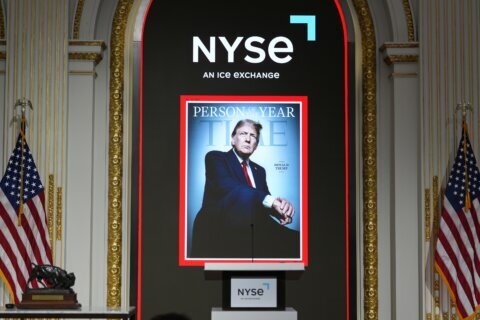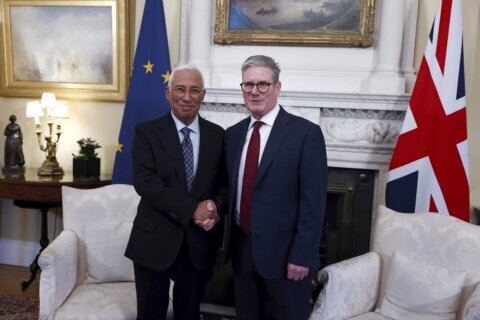HARRISBURG, Pa. (AP) — Democratic Sen. Bob Casey of Pennsylvania leaned into the podium, almost past the microphone, to make his point to the union crowd about how mad corporate leaders are at him.
“But I got news for them,” Casey told Dauphin County Democrats and AFSCME members. “They should get used to it. Because I’m going to continue to prosecute the case on greedflation and shrinkflation.”
For Democrats trying to defend the White House and Senate majority, Casey is emerging as the tip of the spear in attacking “greedflation” — a blunt term for corporations that jack up prices and rip off shoppers to maximize profits — and trying to reframe the election-year narrative about the economy.
Fast-rising prices over the past four years have opened a key soft spot in 2024 for Democrats on an important voter concern, with polls showing that inflation is weighing down President Joe Biden in his bid for a second term against Donald Trump.
It is perhaps no coincidence that Casey is trying to help Biden by making the case against greedflation in the critical presidential swing state he represents, where a victory for Democrats is crucial to keeping the White House and Senate.
No Democrat has won the White House without Pennsylvania’s support since Harry S. Truman in 1948, and a Casey loss would likely guarantee Republican control of a Senate currently divided by the narrowest of margins.
Casey, running for a fourth term, argues that consumer prices are high primarily because of greedflation, a term coined to target corporate profiteering at shoppers’ expense under the cover of inflation. Casey also is attacking greedflation’s cousin, “shrinkflation”: a seemingly covert way for companies to raise prices by slightly reducing product size, like shortening candy bars or putting fewer potato chips in the bag.
For Casey, the argument lines up neatly with the populist politics that have made him a favorite of labor unions, and he has taken on the job with gusto, seemingly spending more time attacking greedflation than his actual opponent in November, Republican David McCormick.
Inflation hit a four-decade high of 9.1% in 2022, more than enough to get the attention of consumers. And blaming greedflation for high prices is perhaps a potent argument both to direct the anger of the squeezed wage earner and deflect Republican accusations that spending under Biden — including his $1.9 trillion pandemic relief package — caused higher prices.
McCormick, a former hedge fund CEO, calls Casey’s contentions “nonsense” and blamed federal spending under Biden and rising energy prices.
“This greedflation-shrinkflation thing is trying to distract the conversation about what really happened,” McCormick said in an interview.
Economists generally don’t subscribe to either side’s black-and-white explanation.
Instead, they tend to list many forces that played a role in global inflation during and after the COVID-19 pandemic, including pandemic-fueled supply-chain shortages worldwide, a strong labor market pushing up wages and Russia’s attack on Ukraine creating energy and food bottlenecks.
Prices in the U.S. remain about 20%, on average, above where they were before the pandemic.
But the U.S. government’s largely successful efforts to rein in inflation without nudging the economy into recession haven’t convinced people that credit is due, especially as rising food and housing prices defy overall slowing inflation rates.
The issue of the economy is No. 1 for many voters, and polls show the impact of inflation is weighing on how voters feel about Biden, despite improving views of the economy, said Christopher Borick, director of the Muhlenberg College Institute of Public Opinion in Allentown.
Borick said he has seen evidence that voters will buy the argument that companies jacked up prices to take advantage of inflation. But, even if they do, voters won’t necessarily give a pass to Biden and Democrats.
“They still are feeling the effects of inflation and their anger could be placed in multiple settings,” Borick said.
Casey has worked mightily to drag greedflation into the spotlight.
He has issued reports, written stern letters to trade associations, gone on national cable news shows and introduced legislation ordering the Federal Trade Commission to investigate price-gouging and shrinkflation as unfair trade practices.
“A lot of these companies said, ‘Oh, well, consumers can just decide not to buy a certain product,’” Casey said in an interview. “It’s like when you go to the grocery store, you got to get food every week. You got to get household items every week or every other week. You don’t have the choice to, you know, defer purchases for six months. It’s not like buying a new television set.”
He bent Biden’s ear about it during a Biden visit to Pennsylvania in January — and subsequently Biden blasted shrinkflation in a video released on Super Bowl Sunday and highlighted a social media post by the “Sesame Street” character Cookie Monster that said, “Me hate shrinkflation! Me cookies are getting smaller.”
In his State of the Union speech, Biden again railed against shrinkflation and promised to crack down on price gouging and “deceptive pricing.”
“Pass Bobby Casey’s bill and stop this,” Biden said. “I really mean it.”
Then, in likely the only mention ever of Snickers candy in a State of the Union address, Biden added: “You probably all saw that commercial on Snickers bars. And you get charged the same amount, and you got about, I don’t know, 10% fewer Snickers in it.”
Mars Inc., which makes Snickers, said it hasn’t reduced the size of Snickers bars.
Casey’s argument goes beyond political messaging and blame terminology.
It’s rooted in a report published last year by the Federal Reserve Bank of Kansas City. In it, Fed researchers say corporate profits contributed 100% of overall inflation in the first year of the recovery and 41% of inflation in 2021-22 — a dynamic similar to other recoveries in the last 70 years.
The Fed’s researchers described it as companies being “forward-looking” by raising prices in anticipation of higher costs.
In one common refrain, Casey asserts that inflation rose by 14% from July 2020 through July 2022, while corporate profits rose by 75% — five times faster. Using federal data, Casey projects that roughly $3,200 of the nearly $5,600 more spent by the average American family in 2021 is due to “corporate profit-taking.”
Some economists say companies can be less restrained by the usual competition in the midst of inflationary price hikes — and take advantage of temporary market power to pad profits.
The liberal economic advocacy group Groundwork Collaborative, for instance, compiled a list of times when corporate executives extolled their profits or price increases, and talked of issuing stock buybacks, increasing dividends or benefiting from high prices or high interest rates.
However, some researchers caution that the extent of profit-taking can be overstated.
Ahmed Rahman, an associate professor of economics at Lehigh University, said corporate profits have added to the inflationary winds, but he doesn’t see enough compelling evidence that greedflation is an important part of inflation, let alone the major driver.
Focusing on corporate profitability is “glib,” Rahman said. “It’s a little bit easy. It resonates during political cycles.”
Prices aren’t going back down, Rahman and other economists say, and it’s more useful for politicians to talk about the impact of upstream markets — like grain, oil and computer chips — when talking about the price of consumer products like potato chips or candy bars.
Besides, even if corporations raised prices more than costs justified, that’s their job, said Z. John Zhang, director of the Penn Wharton China Center at the University of Pennsylvania. Instead of blaming the companies, he said, people should blame the decisions that led to inflation.
“It’s politics and this is really a matter of politicians trying to shift blame for policy-induced inflation,” Zhang said. “And obviously if I were in Biden’s position, that probably is a button I’m going to push, too. It seems to be believable.”
___
AP Economics Writer Christopher Rugaber in Washington contributed to this report.
__
Follow Marc Levy: http://twitter.com/timelywriter
Copyright © 2024 The Associated Press. All rights reserved. This material may not be published, broadcast, written or redistributed.







